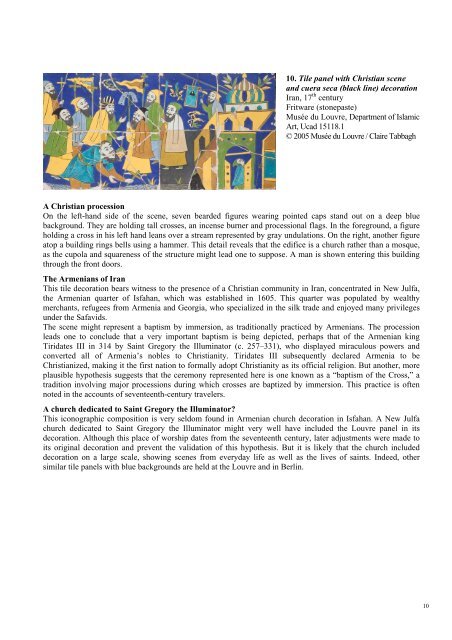The Galerie du Temps at the Louvre-Lens A unique presentation of ...
The Galerie du Temps at the Louvre-Lens A unique presentation of ...
The Galerie du Temps at the Louvre-Lens A unique presentation of ...
You also want an ePaper? Increase the reach of your titles
YUMPU automatically turns print PDFs into web optimized ePapers that Google loves.
10. Tile panel with Christian scene<br />
and cuera seca (black line) decor<strong>at</strong>ion<br />
Iran, 17 th century<br />
Fritware (stonepaste)<br />
Musée <strong>du</strong> <strong>Louvre</strong>, Department <strong>of</strong> Islamic<br />
Art, Ucad 15118.1<br />
© 2005 Musée <strong>du</strong> <strong>Louvre</strong> / Claire Tabbagh<br />
A Christian procession<br />
On <strong>the</strong> left-hand side <strong>of</strong> <strong>the</strong> scene, seven bearded figures wearing pointed caps stand out on a deep blue<br />
background. <strong>The</strong>y are holding tall crosses, an incense burner and processional flags. In <strong>the</strong> foreground, a figure<br />
holding a cross in his left hand leans over a stream represented by gray un<strong>du</strong>l<strong>at</strong>ions. On <strong>the</strong> right, ano<strong>the</strong>r figure<br />
<strong>at</strong>op a building rings bells using a hammer. This detail reveals th<strong>at</strong> <strong>the</strong> edifice is a church r<strong>at</strong>her than a mosque,<br />
as <strong>the</strong> cupola and squareness <strong>of</strong> <strong>the</strong> structure might lead one to suppose. A man is shown entering this building<br />
through <strong>the</strong> front doors.<br />
<strong>The</strong> Armenians <strong>of</strong> Iran<br />
This tile decor<strong>at</strong>ion bears witness to <strong>the</strong> presence <strong>of</strong> a Christian community in Iran, concentr<strong>at</strong>ed in New Julfa,<br />
<strong>the</strong> Armenian quarter <strong>of</strong> Isfahan, which was established in 1605. This quarter was popul<strong>at</strong>ed by wealthy<br />
merchants, refugees from Armenia and Georgia, who specialized in <strong>the</strong> silk trade and enjoyed many privileges<br />
under <strong>the</strong> Safavids.<br />
<strong>The</strong> scene might represent a baptism by immersion, as traditionally practiced by Armenians. <strong>The</strong> procession<br />
leads one to conclude th<strong>at</strong> a very important baptism is being depicted, perhaps th<strong>at</strong> <strong>of</strong> <strong>the</strong> Armenian king<br />
Tirid<strong>at</strong>es III in 314 by Saint Gregory <strong>the</strong> Illumin<strong>at</strong>or (c. 257–331), who displayed miraculous powers and<br />
converted all <strong>of</strong> Armenia’s nobles to Christianity. Tirid<strong>at</strong>es III subsequently declared Armenia to be<br />
Christianized, making it <strong>the</strong> first n<strong>at</strong>ion to formally adopt Christianity as its <strong>of</strong>ficial religion. But ano<strong>the</strong>r, more<br />
plausible hypo<strong>the</strong>sis suggests th<strong>at</strong> <strong>the</strong> ceremony represented here is one known as a “baptism <strong>of</strong> <strong>the</strong> Cross,” a<br />
tradition involving major processions <strong>du</strong>ring which crosses are baptized by immersion. This practice is <strong>of</strong>ten<br />
noted in <strong>the</strong> accounts <strong>of</strong> seventeenth-century travelers.<br />
A church dedic<strong>at</strong>ed to Saint Gregory <strong>the</strong> Illumin<strong>at</strong>or?<br />
This iconographic composition is very seldom found in Armenian church decor<strong>at</strong>ion in Isfahan. A New Julfa<br />
church dedic<strong>at</strong>ed to Saint Gregory <strong>the</strong> Illumin<strong>at</strong>or might very well have included <strong>the</strong> <strong>Louvre</strong> panel in its<br />
decor<strong>at</strong>ion. Although this place <strong>of</strong> worship d<strong>at</strong>es from <strong>the</strong> seventeenth century, l<strong>at</strong>er adjustments were made to<br />
its original decor<strong>at</strong>ion and prevent <strong>the</strong> valid<strong>at</strong>ion <strong>of</strong> this hypo<strong>the</strong>sis. But it is likely th<strong>at</strong> <strong>the</strong> church included<br />
decor<strong>at</strong>ion on a large scale, showing scenes from everyday life as well as <strong>the</strong> lives <strong>of</strong> saints. Indeed, o<strong>the</strong>r<br />
similar tile panels with blue backgrounds are held <strong>at</strong> <strong>the</strong> <strong>Louvre</strong> and in Berlin.<br />
10



